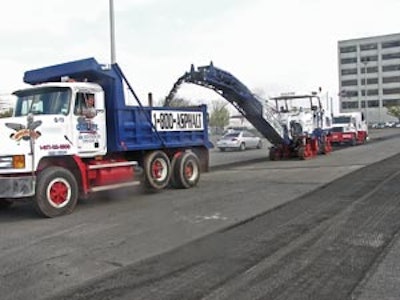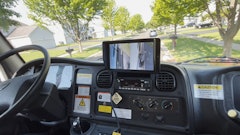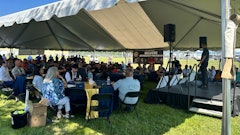
When a contractor is looking to make a splash in the market it most-often turns to its marketing efforts, where the logo and corporate colors can be changed to demonstrate a revitalized, high-impact presence. If it's done right name recognition grows, business grows, profits grow, and the company is on track for market dominance.
Looks like Quality Shopping Center Maintenance did it right. They redesigned their logo and introduced a highly recognized color scheme, and anyone living or working in the New Jersey/Staten Island market has probably seen and remembered the bright red, white, and blue construction equipment with the Twin Towers incorporated into the logo.
Michael Piazza, vice president and partner with Ted Albanese, president, says that as Quality Shopping Center Maintenance was reconsidering its marketing scheme, New York City underwent the attack on the World Trade Center and suffered the loss of almost 3,000 people. Everything came together at once – the company considering a new logo, new color scheme, and a desire to honor the people who died in the World Trade Center and demonstrate the patriotism the company felt for the country – and the direction was clear.
"We know quite a few people who were in the towers, and we know people who had friends and family in the towers. We wanted to do something to commemorate them," Piazza says.
So first they established a corporate color for equipment…white, which was soon followed by red and blue. Ever since 9-11 every unit Quality Shopping Center Maintenance puts in the field has a red, white, and blue color scheme. Even the contractor's wheelbarrows and light towers are painted red, white, and blue.
In addition, Quality Shopping Center Maintenance designed a new logo using the downed Twin Towers as the "L" and the "I" in "Quality." Plus, each piece of equipment flies Old Glory with the contractor's logo embroidered in the fabric of the flag.
"We're trying to set a precedent," Piazza says. "We're out there sweeping every day, our trucks are out there, and our maintenance vehicles are out there. We get so much eye traffic because of the red, white, and blue. Ever since we added the red, white, and blue color scheme business has just taken off."
Albanese and Benny Guzman do most of the painting, and trucks are painted when they're acquired and touched up or repainted on an as-needed basis. The contractor has its own spray shop on site, and stick-on letters and stencils are used for the intricate designs and logo. Piazza estimates it would cost between $2,500 and $4,000 to paint a piece of equipment in three colors.
In addition to painting the equipment, Albanese names many of it. Some of the monikers include the Liberator, Stars & Stripes, the Patriot, the Veteran and Old Soldier.
"They all thought I was nuts when I said I wanted the equipment painted in three colors, but they don't think I'm nuts anymore," Piazza says. "We really set the market for ourselves since we went to the new colors and logo."
Now a one-call contractor
Ted Albanese should give lectures in how to transform a business. He started the company in 1970 as trucking and excavating business, adding paving in 1973. He added parking lot sweeping and shopping center maintenance in 1985, and today does no trucking or excavating, instead concentrating on servicing the commercial customer.
"Until he brought me in Ted did everything," says Piazza, son-in-law to Albanese, also known as Cousin Vinny. "He was operations, mechanic, estimator, payroll, everything, but there's only so much one guy can do. When I came aboard that freed him up and now he has the time to do other things, which are helping us grow like we have."
Piazza says he is more an office-type where Albanese enjoys being out on the jobs. "We're a great team and it's a great team effort. We're hoping we can grow two times or even four times over the next few years.
"We view ourselves as a one-call contractor for shopping centers and that's how we want our clients to view us too," Piazza says.
"There are a lot of pavers out there but not a lot of pavers who do everything," Piazza says. "We sell the whole ball of wax. We tell the property manager that if he has to call 10 people to get 10 different things done, that's a big drain on his time. Instead he can just call us and we'll take care of it all for him.
"And as far as the parking lot is concerned we're really his eyes out there because we're on the lot every day or every other day sweeping it, so we notice when lights are out or if there are potholes or trip hazards, or whatever the problem is. We can let him know of the problem before it becomes a liability. And we can tell him what needs to be done and he can tell us to take care of it. All in one call."
Quality Shopping Center Maintenance handles 43 malls and strip malls as regular clients. They also work with contractors on private developments, and they market to contractors who pursue national accounts but need subcontractors to do work for them in the area.
The company employs 35 people, and works 100 miles in any direction from offices in Toms River and Staten Island.
"We don't want to get too big and we don't want to travel too far, we just want take care of the area we have and generate as much work as we can from within that area."
He says the company has grown steadily, particularly in the last five years when each year they've almost doubled sales of the year before.
Piazza says that while sweeping accounts for only 15% of total sales (paving is 50% and sealcoating is up to 10%), it is the service that drives the rest of the company's work.
"We get in the door with our sweeping. The sweeping company is the ‘in,'" Piazza says. "We market that because it's something no one else really does in this market."
Servicing the customer
"We'll do anything that we have to do in the paving and pavement maintenance area," Piazza says.
Planning. An important service is assisting its customers with budgets.
"We'll create their budgets for them if that's what they want, and many of our clients take advantage of that service," he says. "We take digital pictures of the property and its problem areas, color code a site plan to show them what areas need what kind of work, and combine that with aerial photos to give them an overview of their property. This helps them plan out their expenses; it helps us because it does generate a lot of work on most sites."
Paving & milling. Piazza says the contractor has operated small pavers for years but a few years ago added the LeeBoy 8515.
This year they company bought a Marini milling machine at National Pavement Expo. "Most of the work we get is big commercial work so it got to the point where it didn't make sense to sub milling out anymore," he says. "We have enough milling to keep ourselves busy and we also can rent the machine out as a sub to other contractors if we need to."
Sealcoating. Sealcoating is not a focus of the business, but they do sell and perform the work – but not for everyone. "I won't seal if I don't pave," he says. They schedule all sealcoating work into a 60- or 90-day window.
"That way we only disrupt the other crews for a short time and we only have that crew running part of the season."
Global Positioning Systems. "GPS has been extremely successful, just from the customer satisfaction alone it's worth its price," Piazza says. All sweepers are equipped with Abroad GPS system and software, which tracks a variety of functions, including what time the driver drove on and off the lot.
"The property manager can look at the route and see where we were, when we were there, and how long we were there. And if we should have been there 90 minutes and were only there 60 minutes he can see that and he can ask us why that was," Piazza says. "On the other side, if a lot should take 90 minutes and our driver spent 3 hours there, we need to know that and need to know why that happened. It's a system that works for both us and the customer. It really gives the property managers a sense of security knowing they can check when we were there, and it helps us track our crew and productivity."
He says using the GPS has also enabled the company to better evaluate its employees.
"It helped us weed out the people we don't want around, the people who weren't doing what they were supposed to be doing," Piazza says. "That's especially important because we don't have a night manager so we need reliable people who are going to do what they need to do."


![Pavement Awards 2025[main]](https://img.forconstructionpros.com/files/base/acbm/fcp/image/2024/05/PavementAwards_2025_main_.664253a724bb1.png?auto=format%2Ccompress&bg=fff&fill-color=fff&fit=fill&h=100&pad=5&q=70&w=100)








![Pavement Awards 2025[main]](https://img.forconstructionpros.com/files/base/acbm/fcp/image/2024/05/PavementAwards_2025_main_.664253a724bb1.png?ar=16%3A9&auto=format%2Ccompress&bg=fff&fill-color=fff&fit=fill&h=135&pad=5&q=70&w=240)









